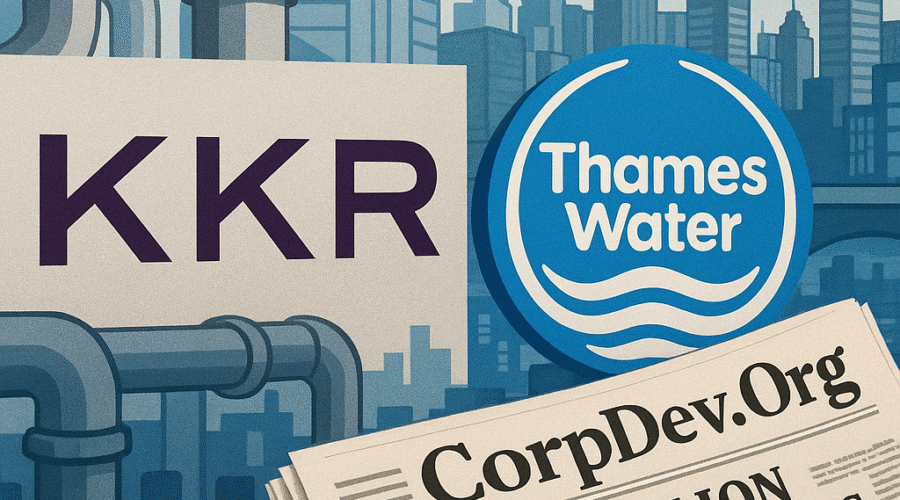As Thames Water teeters on the brink of financial collapse, KKR’s proposed £8 billion debt restructuring plan emerges as the most ambitious private sector rescue attempt in UK utility history. This complex financial engineering exercise – combining equity injections, creditor haircuts, and regulatory negotiations – could redefine infrastructure investing in regulated markets. With £20 billion of debt and urgent operational needs, the outcome will test the limits of private equity’s value-creation playbook in essential public services.
The Anatomy of KKR’s Debt Reduction Strategy
Targeted Debt Layers
KKR’s plan surgically addresses Thames Water’s capital structure through three concentric layers of debt relief. The first £3 billion write-off targets Class B bonds and shareholder loans – junior instruments carrying higher yields but lower recovery priority[9][12]. This aligns with court documents showing junior creditors facing <5% recoveries in restructuring scenarios[6][8].
The second tranche proposes £5 billion reductions from senior Class A debt, a move enabled by KKR’s £4 billion equity injection serving as consideration for creditor concessions[2][11]. This “equity-for-debt” swap mirrors techniques used in 2020s energy sector restructurings, though unprecedented in scale for UK utilities[12].
Capital Structure Reengineering
Post-restructuring, Thames Water’s debt/EBITDA ratio would plummet from 14x to 6x – still high for utilities but within manageable range given regulated cash flows[4][10]. The plan leverages Ofwat’s recent acceptance of higher leverage ratios in exchange for infrastructure commitments[5][11]. KKR’s operational turnaround blueprint assumes £7 billion in capex through 2030, partially funded through customer bill increases now under CMA review[5][10].
Creditor Dynamics: A Battle for Priority
Class A vs. Class B Standoff
The restructuring exposes fundamental tensions between Thames Water’s £11.5 billion Class A bondholders and £3 billion Class B cohort. Class A creditors – including PIMCO and Silver Point – initially pushed for seniority protection through super-priority loans[6][12]. KKR’s proposal upends this hierarchy by demanding proportional haircuts, arguing shared pain prevents value destruction through administration[8][13].
Hedge Fund Counterplays
Elliott Management’s £750 million Class B position complicates negotiations. Known for aggressive recovery tactics in Argentina and Samsung disputes, Elliott is reportedly accumulating debt at 30-40p/£1 while lobbying for asset sales[7][9]. This creates parallel restructuring tracks – KKR’s operational fix vs. Elliott’s liquidation-oriented approach – with Ofwat forced to mediate between competing visions[3][11].
Regulatory Tightrope: Ofwat’s Impossible Equation
Tariff Approval Timelines
KKR’s entire proposal hinges on Ofwat approving 40% bill increases over five years – a political grenade given Thames Water’s sewage spill record[4][5]. The CMA’s 18-week review pause provides temporary relief, but final determinations could still cap returns below private equity’s 12-15% hurdle rates[10][11].
Public vs. Private Interest
Regulators face mounting pressure to prevent “gold plating” of infrastructure spending. KKR’s £7 billion capex plan includes smart metering and leakage reduction – popular with environmentalists but requiring 25-year payback periods[4][5]. The firm’s $1 million Trump inauguration donation[1] further complicates public acceptance, fueling nationalization calls from Labour backbenchers[3][13].
Market Implications: Redrawing the Infrastructure Playbook
PE Adaptation to Regulated Returns
KKR’s hands-on approach – retaining operational control while accepting single-digit IRR targets – signals private equity’s maturation in infrastructure[2][3]. The firm plans to deploy its operational partners division, using AI-driven maintenance systems from recent European utility acquisitions to boost Thames’ efficiency[3][11].
Creditor Co-Investment Models
The proposed structure allows Class A creditors to roll debt into new equity – a novel solution to align stakeholder interests. If successful, this could create template for future regulated sector restructurings, blending PE capital with creditor expertise[9][12]. However, inter-creditor disputes over governance rights remain unresolved[8][13].
Execution Risks: The Road Ahead
Legal Minefields
Junior creditors are preparing challenges under UK’s new Restructuring Plan framework, arguing KKR’s plan unfairly prejudices their recovery rights[12][13]. The High Court’s February ruling approving emergency loans set precedent for creditor cram-downs, but £8 billion in write-offs could trigger unprecedented litigation[6][8].
Operational Turnaround Complexity
Even with debt relief, Thames Water requires massive infrastructure upgrades. KKR’s team must navigate labor shortages, environmental permitting delays, and Ofwat’s new outcome-based incentives – all while maintaining service levels for 16 million customers[4][5]. Historical failures in Macquarie’s ownership era loom large as cautionary tale[4][11].
Conclusion: A Watershed for Privatized Utilities
KKR’s Thames Water play represents the ultimate stress test for private infrastructure ownership models. Success could unlock £100 billion in global utility investments by proving PE can reconcile public service obligations with institutional returns. Failure risks rekindling 1970s-style nationalization debates, with regulators potentially imposing draconian equity caps. As May deadlines approach, the delicate dance between Wall Street financial engineering and Whitehall public policy will determine not just Thames’ fate, but the future of essential service privatization worldwide.
Sources
https://www.desmog.com/2025/05/01/thames-water-prospective-new-owner-kkr-donated-1-million-donald-trump-inauguration/, https://www.nbcphiladelphia.com/news/business/money-report/u-s-fund-kkr-makes-4-billion-management-buyout-bid-for-uks-thames-water/4113612/?os=vb_73kqvpgino_journeys%3Dtrue&noamp=mobile, https://news.sky.com/story/investment-giant-kkr-advances-plan-for-thames-water-rescue-bid-13302348, https://theboar.org/2024/09/why-thames-water-is-drowning-in-debt/, https://www.thameswater.co.uk/news/cma-and-equity-raise-update, https://theedgemalaysia.com/node/744920, https://www.proactiveinvestors.com/companies/news/1055788/elliott-leading-hedge-fund-rush-into-thames-water-debt-says-report-1055788.html, https://www.the-independent.com/news/business/creditors-in-high-court-row-over-thames-water-restructuring-plans-b2665737.html, https://www.tradingview.com/news/reuters.com,2025:newsml_L4N3RQ060:0-thames-water-creditors-to-write-off-6-billion-pounds-if-kkr-takes-control-the-times/, https://assets.publishing.service.gov.uk/media/68131a2296fbee80400085f5/Investors_in_Thames_Water.pdf, https://www.cityam.com/thames-water-says-it-has-received-six-takeover-offers/, https://www.paulweiss.com/insights/client-memos/three-s-a-crowd-the-thames-water-restructuring-plan-s, https://www.mallowstreet.com/Article/b76555, https://www.createafreewebsite.net/article.html, https://www.alooba.com/skills/concepts/front-end-development-316/html5-semantics/, https://www.tutorialspoint.com/How-to-add-an-article-in-HTML5, https://www.techfry.com/html-tutorial/new-html5-semantic-markup, https://www.w3resource.com/html5/article-tutorial.php, https://quokkalabs.com/blog/what-are-html5-semantic-tags-and-how-to-use-them/





